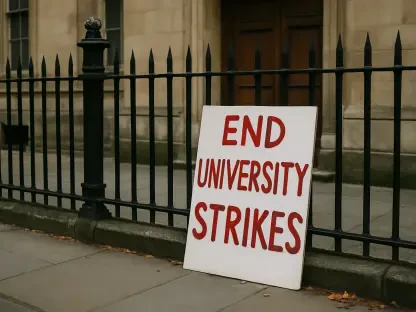In a landscape where higher education faces intense scrutiny, a staggering statistic emerges: minority enrollment at selective colleges has declined significantly since a landmark Supreme Court ruling in 2023 banned race-conscious admissions, and this shift is compounded by new directives from President Trump. These policies, which place college admissions and federal research grants under a transformative spotlight, aim to enforce meritocracy and align academic pursuits with national priorities, sparking heated debates among educators, researchers, and advocacy groups. This roundup gathers diverse opinions, insights, and practical tips from various stakeholders to unpack the implications of these directives. The purpose is to provide a balanced perspective on how these changes are reshaping the academic world and what they mean for students, institutions, and scholars.
Diverse Voices on Trump’s Higher Education Directives
Admissions Data Transparency: Merit or Barrier?
The directive mandating colleges to report detailed admissions data, including race, test scores, and GPAs, has stirred a wide range of reactions. Proponents within conservative policy circles argue that this push for transparency ensures a level playing field, preventing race-based preferences from influencing decisions. Many believe this aligns with a broader societal demand for fairness, emphasizing that admissions should reflect individual achievement over demographic factors.
On the other hand, numerous advocacy groups focused on educational equity express deep concern over the potential consequences. They contend that such granular reporting could discourage diversity by exposing institutions to legal challenges or public backlash if their data reveals disparities. Some educators highlight that this policy may pressure colleges to prioritize metrics over holistic evaluations, potentially sidelining underrepresented students.
A third perspective comes from administrative leaders at higher education institutions, who point out the logistical burden of compliance. They note that compiling and verifying extensive datasets for audits by federal bodies will strain resources, especially for smaller colleges. While acknowledging the intent behind merit-based systems, these leaders question whether the policy might inadvertently harm the very fairness it seeks to promote by creating new administrative barriers.
Research Grant Oversight: National Interest or Political Control?
Trump’s executive order empowering political appointees to review and terminate federal research grants has ignited a firestorm of opinions. Supporters within policy think tanks aligned with the administration’s goals argue that this measure ensures taxpayer funds support research reflecting national priorities. They emphasize the focus on institutions with lower indirect cost rates as a way to democratize funding access, potentially benefiting smaller or less traditional research entities.
Conversely, a significant portion of the academic research community views this as a direct threat to intellectual freedom. Many scholars and scientific organizations caution that allowing political oversight of grant allocations risks stifling innovation, especially in fields like social sciences where topics such as critical race theory are already under scrutiny. They warn that ideological alignment could replace rigorous peer review as the deciding factor in funding decisions.
Legal analysts offer another angle, pointing to historical precedents where similar attempts at grant control faced judicial pushback. They suggest that while the intent to align research with policy goals may resonate with fiscal conservatives, past rulings indicate a likelihood of legal challenges. This perspective underscores a tension between governmental authority and the autonomy traditionally afforded to scientific inquiry, raising questions about the long-term viability of such oversight.
Ideological Shifts: Redefining Academic Values?
The broader ideological push against diversity, equity, and inclusion (DEI) initiatives embedded in these directives has polarized opinions across the educational spectrum. Conservative commentators applaud the rejection of what they see as progressive overreach in academia, arguing that higher education has drifted too far from traditional values of merit and objectivity. They view these policies as a necessary correction to restore balance in institutional priorities.
In contrast, progressive educators and student organizations argue that dismantling DEI frameworks undermines efforts to address systemic inequalities. They stress that such policies could exacerbate existing disparities, particularly in regions where state-level bans on race-conscious admissions already limit diversity. Their concern centers on the potential for a chilling effect, where institutions self-censor to avoid federal repercussions.
A more nuanced take comes from regional academic associations, which highlight the uneven impact of these ideological shifts. They note that states with stronger resistance to federal overreach may buffer some effects, while others could see rapid changes in campus culture and research focus. This disparity suggests that the reshaping of academic norms might create a patchwork of outcomes, complicating national discussions on fairness and inclusion.
Fiscal Restraint vs. Academic Freedom: A Delicate Balance?
The dual emphasis on cost-effectiveness and ideological alignment in research funding draws varied reactions from fiscal and academic communities. Budget analysts supportive of the administration’s approach praise the focus on lower indirect cost rates, suggesting it could redirect resources to a broader array of institutions. They argue that this fiscal restraint might encourage efficiency and innovation in how research is conducted and funded.
Academic critics, however, warn that prioritizing cost over content could undermine groundbreaking work typically supported by larger, well-funded institutions. They fear that smaller entities, while gaining access to grants, may lack the infrastructure to tackle complex projects, potentially lowering the overall quality of research output. This viewpoint raises concerns about long-term impacts on scientific advancement in the country.
Policy experts with a historical lens add that balancing fiscal goals with academic freedom has always been contentious. They reference past legal challenges to grant oversight as evidence that such policies often struggle to withstand scrutiny when they appear to infringe on scholarly independence. This perspective suggests a tightrope walk where short-term budgetary wins might come at the expense of sustained intellectual progress.
Practical Tips for Navigating the New Academic Landscape
For colleges grappling with the admissions data directive, several institutional advisors recommend proactive preparation for rigorous federal audits. They suggest investing in robust data management systems to ensure accuracy and compliance, while also engaging legal counsel to navigate potential challenges. This approach aims to minimize disruptions while meeting new reporting standards.
Researchers facing uncertainty in grant funding are advised by academic networks to diversify their funding sources. Exploring private foundations, industry partnerships, and international collaborations could provide a buffer against potential federal cuts or terminations. Additionally, aligning project proposals with broadly accepted national interests, without compromising core objectives, might help in securing approvals under the new review process.
Students and educators, meanwhile, are encouraged by advocacy coalitions to actively participate in policy discussions at both institutional and national levels. Forming alliances with like-minded peers to advocate for diversity and academic freedom can amplify their voices. Staying informed about regional variations in policy implementation also equips them to adapt strategies based on local contexts, ensuring their concerns are addressed effectively.
Reflecting on the Discourse and Next Steps
Looking back, the roundup of perspectives on Trump’s directives revealed a deeply divided landscape, where the pursuit of meritocracy and national alignment clashed with concerns over diversity and academic freedom. The debates captured a spectrum of hopes and fears, from optimism about fairness and fiscal responsibility to apprehensions about stifled innovation and reduced inclusivity. Moving forward, stakeholders should consider forming cross-sector coalitions to monitor policy impacts over the next few years, particularly from 2025 onward. Engaging in constructive dialogue with policymakers to propose balanced alternatives could help mitigate unintended consequences. Additionally, exploring case studies of institutions that successfully adapt to these changes might offer valuable lessons for broader application, ensuring that higher education remains a space for both equity and excellence.









